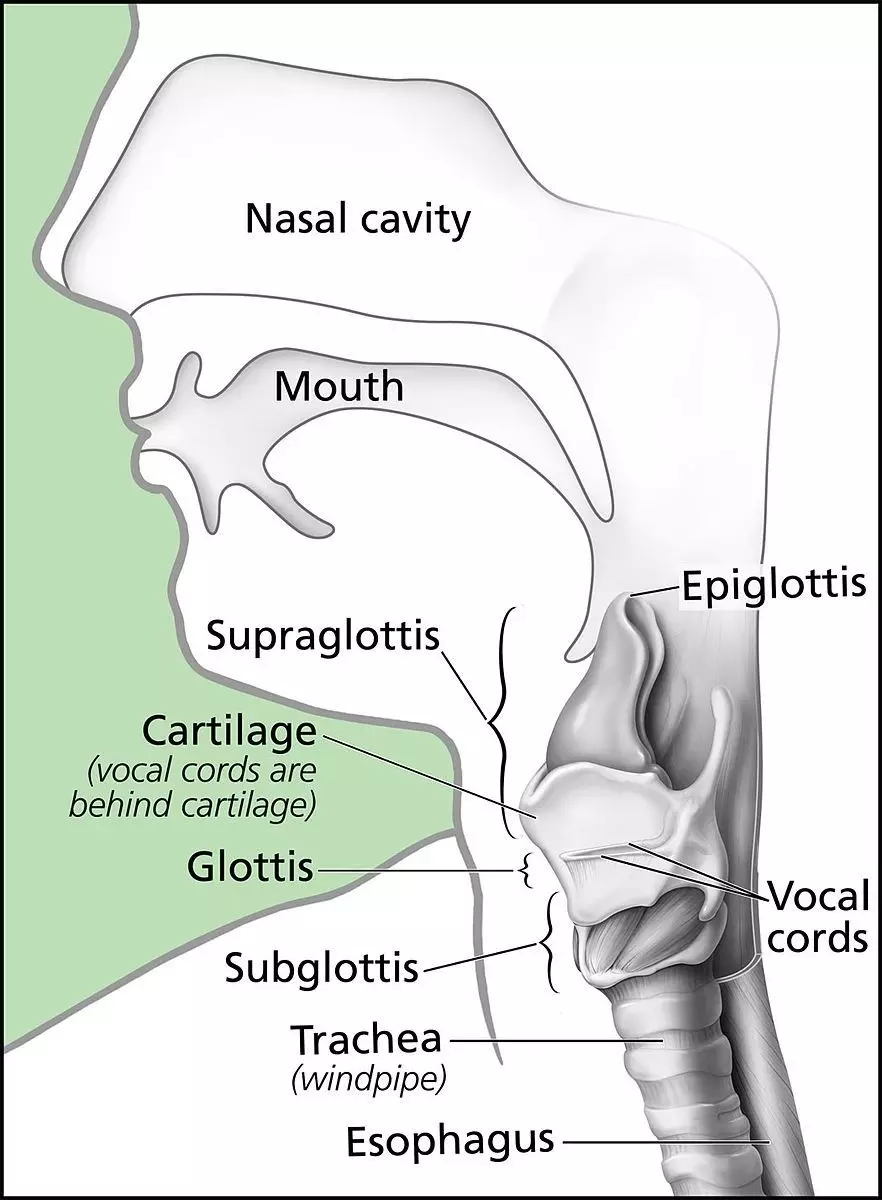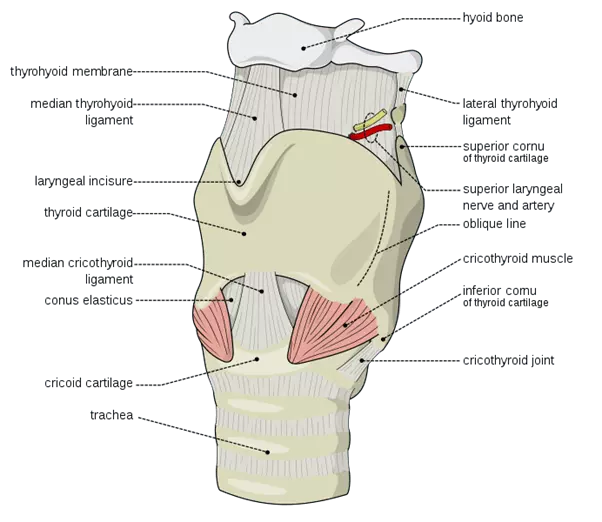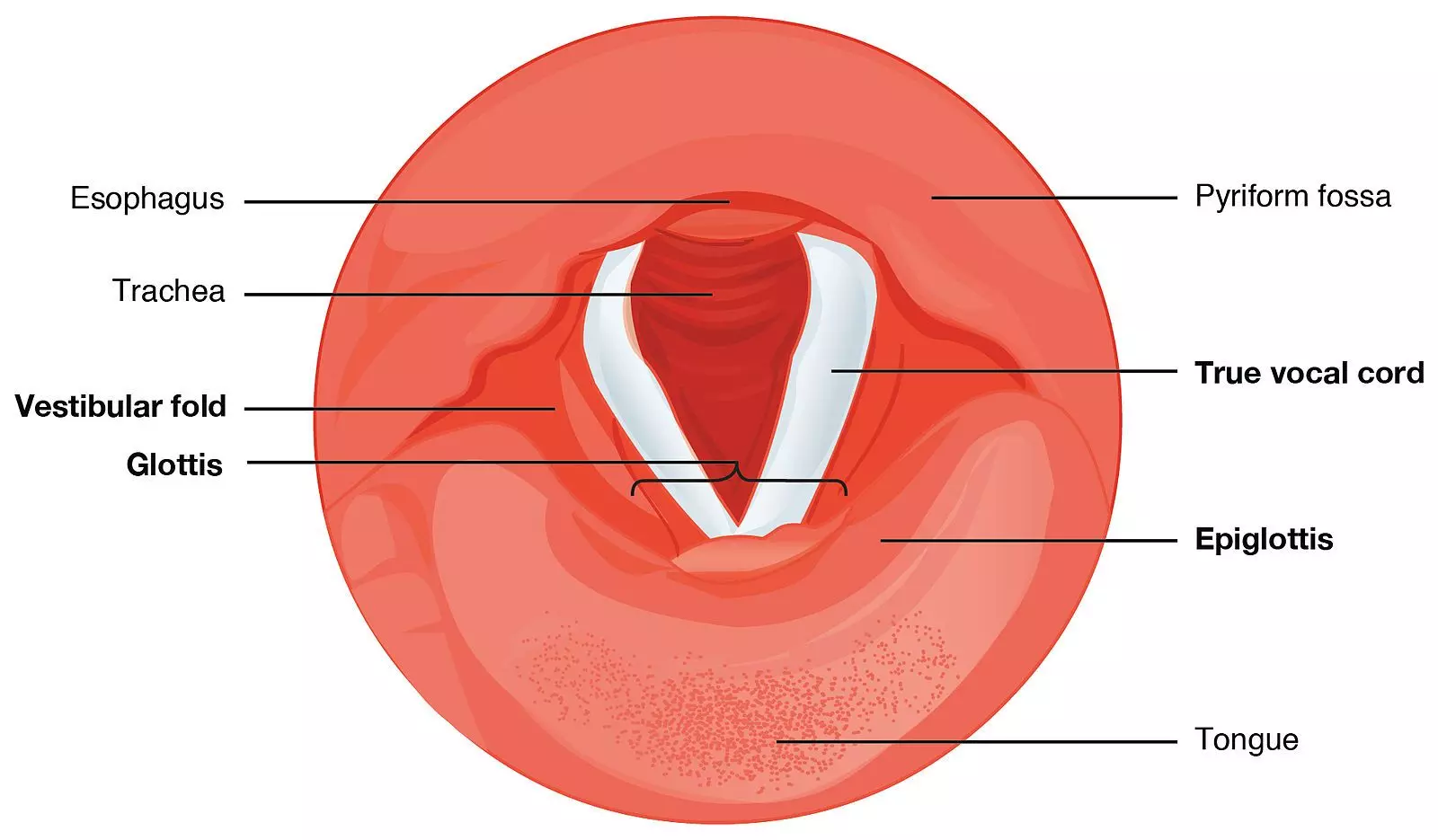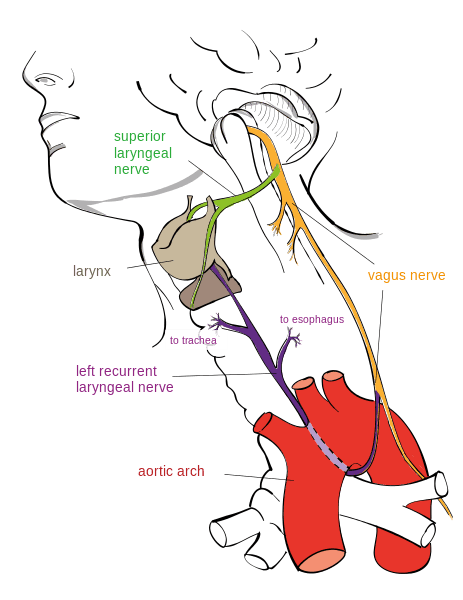By Joshua Bray
Next Lesson - Head and Neck Cancers
Abstract
- The larynx is part of the respiratory tract found in the anterior neck.
- Functions of the larynx include airway protection, ventilation, coughing and phonation.
- The larynx is divided into 3 sections: the supraglottis, glottis and infraglottis.
- The larynx has 9 cartilages: 3 paired and 3 unpaired.
- Laryngeal cartilages are connected by various membranes and ligaments.
- The larynx has many muscles: extrinsic muscles move the entire larynx while intrinsic muscles act on the vocal cords.
- The larynx is innervated by branches of the vagus nerve.
- Many conditions can present with hoarseness of voice: these include acute laryngitis, croup, epiglottitis, laryngeal nodules, laryngeal cancer and recurrent laryngeal nerve palsy.
- Epiglottitis is a medical emergency as it compromises airway patency.
Core
The larynx (‘voice box’) is a component of the respiratory tract found in the anterior neck. It lies at the level of the C3-6 vertebral bodies and connects the oropharynx to the trachea.
The larynx has several functions:
- Airway Protection – this is arguably the most important role of the larynx, preventing food and fluid from entering the airways. When food/fluid enters the airway, this is known as aspiration.
- Ventilation – as part of the respiratory tract, the larynx provides a channel for the movement of air in and out of the lungs.
- Coughing – the larynx plays an important role in the cough reflex, which rapidly expels unwanted material from the respiratory tract.
- Phonation – the production of sound.
The larynx lies anterior to the laryngopharynx. Food should not enter the larynx and is normally diverted into the laryngopharynx via recesses called the piriform fossae.
The larynx is divided into 3 sections: the supraglottis, glottis and infraglottis. The glottis (or rima glottidis) is the narrow area at the level of the vocal cords and divides the supraglottis and infraglottis.

Diagram - Anatomy of the larynx
Public Domain Source by Alan Hoofring (Illustrator), edited by Joshua Bray [Public domain]
The larynx is formed by a framework of cartilages, membranes and ligaments which is all lined by respiratory mucosa.
The laryngeal skeleton consists of 9 cartilages: 3 are single and 3 are paired.
The 3 unpaired cartilages are:
- Epiglottis – the most superior of the laryngeal cartilages, the epiglottis is a heart-shaped cartilage which plays an important role in airway protection. Its elastic cartilage allows it to fold over the laryngeal inlet while swallowing to prevent material from entering the larynx. It lies just posterior to the root of the tongue and the space between the two is known as the vallecula.
- Thyroid Cartilage – the largest of the cartilages, the thyroid cartilage consists of two laminae which extend anteriorly and join to form the laryngeal prominence (Adam’s apple).
- Cricoid Cartilage – the most inferior cartilage, the cricoid cartilage is a complete ring of hyaline cartilage which encircles the airway and forms the inferior border of the larynx. It is shaped like a signet ring with its band facing anteriorly.
The 3 paired cartilages are:
- Arytenoid Cartilages – these pyramid-shaped cartilages articulate with the superior aspect of the cricoid cartilage. These cartilages are important as the provide attachment for the aryepiglottic folds and are also visible on laryngoscopy.
- Corniculate Cartilages – these smaller cartilages articulate with the apex of the arytenoid cartilages.
- Cuneiform Cartilages – these cartilages sit within the aryepiglottic folds to provide reinforcement to the folds.
These cartilages are connected by numerous membranes and ligaments to unite the larynx as a single structure.
Three membranes connect the unpaired cartilages of the larynx to each other and to other nearby structures:
- Thryohyoid Membrane – connecting the hyoid bone to the thyroid cartilage.
- Cricothyroid Membrane – connecting the thyroid cartilage to the cricoid cartilage. A cricothyroidotomy involves making a hole in this membrane in order to create an emergency airway.
- Cricotracheal Membrane – connecting the cricoid cartilage to the 1st tracheal cartilage.

Diagram - External laryngeal cartilages and membranes
Creative commons source by Olek Remesz [CC BY-SA 4.0 (https://creativecommons.org/licenses/by-sa/4.0)]
The quadrangular membrane spans between the epiglottis and arytenoid cartilages. The free edges of this form important structures:
- Aryepiglottic Folds – formed by the superior free edge of the quadrangular membrane, connecting the epiglottis to the arytenoid cartilages. These form an oval entrance to the larynx called the laryngeal inlet.
- Vestibular Ligaments – formed by the inferior free edge of the quadrangular membrane, connecting the angle of the thyroid cartilage to the arytenoid cartilage. These are otherwise known as the false vocal cords.
The true vocal cord, otherwise known as the vocal ligament, is formed by the thickened superior free border of the cricothyroid ligament.

Diagram - View of the larynx and vocal cords on nasendoscopy
Creative commons source by OpenStax College [CC BY-SA 4.0 (https://creativecommons.org/licenses/by-sa/4.0)]
The larynx is lined predominantly lined with pseudostratified ciliated epithelium, except for the true vocal cord which is lined by stratified squamous non-keratinised epithelium.
The larynx has many muscles. This article will focus on some of the more important muscles.
In broad terms, there are 2 groups of laryngeal muscles: extrinsic and intrinsic. The extrinsic muscles attach the larynx (directly or indirectly) to other structures and act to move the entire larynx. The intrinsic muscles are found within the larynx itself and act primarily on the vocal cords.
Extrinsic Muscles:
- Stylopharyngeus – this muscle of the pharynx acts to elevate the larynx.
- Suprahyoids – this group of muscles act to elevate the hyoid bone and therefore elevate the larynx.
- Infrahyoids – this group of muscles act to depress the hyoid bone and therefore depress the larynx.
Intrinsic Muscles:
Most of the intrinsic laryngeal muscles (e.g. lateral cricoarytenoid, transverse arytenoid) act to adduct the vocal cords. Other important muscles of note are:
- Posterior Cricoarytenoids – this pair of muscles are the only muscles to abduct the vocal cords.
- Cricothyroid – this pair of muscles increase tension in the vocal cords in order to produce higher pitched sounds.
The larynx executes different movements depending on the action which is being performed:
- Ventilation – when taking a deep breath in or out, the vocal cords are fully abducted (via posterior cricoarytenoids) in order to create a wide airway.
- Phonation – in order to create sounds, the vocal cords adduct to vibrate a thin column of air. The pitch of the sound created is altered by varying the length and tension of the vocal cords (via cricothyroid).
- Coughing – in order to produce a cough, the vocal cords initially adduct in order to build up intrathoracic pressure. The cords then suddenly snap open which causes the air to be expelled at a high velocity.
During swallowing, it is imperative that food/drink does not enter the airway (aspiration). To avoid this, the larynx has several protective mechanisms:
- The vocal cords adduct in order to close the glottis.
- Contraction of the aryepiglottic muscles acts to narrow the laryngeal inlet and fold the epiglottis over the inlet.
- The larynx is pulled upwards by contraction of stylopharyngeus and the suprahyoid muscles. This helps to close the laryngeal inlet.
The larynx is innervated by branches of the vagus nerve (CN X). These branches are the superior laryngeal nerve and the recurrent laryngeal nerve.
The recurrent laryngeal nerve has an important path, branching distally from the vagus nerve and then travelling back on itself towards the larynx:
- Right Recurrent Laryngeal Nerve – loops under the right subclavian artery
- Left Recurrent Laryngeal Nerve – loops under the aortic arch

Diagram - Course of the left recurrent laryngeal nerve
Creative commons source by Jkwchui [CC BY-SA 4.0 (https://creativecommons.org/licenses/by-sa/4.0)]
In terms of sensory innervation, the supraglottis is supplied by the internal branch of the superior laryngeal nerve, while the infraglottis is supplied by the recurrent laryngeal nerve. The innervation of the glottis is somewhat disputed but many accept that it is innervated by the recurrent laryngeal nerve.
As for motor supply, all intrinsic muscles of the larynx are innervated by the recurrent laryngeal nerve, except for cricothyroid which is innervated by the external branch of the superior laryngeal nerve.
Injury to the recurrent laryngeal nerve leads to paralysis of the ipsilateral vocal cord.
- If the lesion is unilateral – this will lead to a hoarse voice and/or an ineffective cough reflex. These lesions are often well tolerated as the contralateral vocal cord compensates over time.
- If the lesion is bilateral – this is a surgical emergency. Both vocal cords are paralysed and lie in a paramedian position, which compromises the airway. An emergency airway is needed.
Conditions Affecting the Larynx
Acute laryngitis is inflammation of the larynx. It is associated with upper respiratory tract infections, most commonly parainfluenza and measles. Symptoms include dry cough, hoarse voice and sore throat. If the inflammation extends to the trachea and bronchi, this is known as laryngotracheobronchitis, or croup. Croup is common in children and is characterised by stridor and a barking cough (which sounds like a seal).
Epiglottitis is inflammation of the epiglottis. It is a medical emergency as the swollen epiglottis can compromise the airway. It presents with dyspnoea, stridor, hoarseness of voice and often drooling. Patient’s must be intubated by a specialist as soon as possible to secure a definitive airway. The most common cause of epiglottitis is Haemophilus influenzae B (HiB) infection. For this reason, children are routinely vaccinated against HiB in the UK.
The airway can also become compromised during anaphylaxis, a severe allergic reaction where histamine release by mast cells results in laryngeal oedema. Securing a definitive airway is a priority in these patients.
Laryngeal nodules (vocal nodules) are benign growths on the vocal cords. They are generally due to voice overuse which causes chronic irritation of the vocal cords. Therefore, they are common singers, cheerleaders, teachers, etc. Patients generally present with voice changes (e.g. hoarse, raspy, low-pitched voice) and/or pain in the throat. Initial treatment is vocal rest, however, if this does not work the nodules can be removed surgically.
Laryngeal cancer often presents with voice changes. Other symptoms include dysphagia, globus and weight loss. On rare occasions a neck lump may be palpable. The mainstay of treatment is surgery. For more information, see our article on Head and Neck Cancers.
Reviewed by: Dr. Thomas Burnell
- 9489

